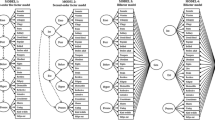Abstract
Psychiatric diagnoses and objective parent checklists are alternative ways to describe child adjustment problems. There has recently been interest in evaluating the degree of agreement or convergence between these sources of information. This paper addresses three issues neglected by researchers in this area. The appropriateness of the use of indices of sensitivity and specificity to describe the correspondence of diagnoses and checklist scores is questioned. Implications of failure to consider the reliability of diagnoses in interpreting diagnosis-checklist agreement are discussed. Also, possible parameters of diagnosis-checklist agreement that should be identified by researchers are reviewed. Suggestions for improving research in this area are offered.
Similar content being viewed by others
References
Achenbach, T. M. (1978). The Child Behavior Profile: I. Boys aged 6–11.Journal of Consulting and Clinical Psychology, 46, 478–488.
Achenbach, T. M. (1980). DSM-III in light of empirical research on the classification of child psychopathology.Journal of the American Academy of Child Psychiatry, 3, 395–412.
Achenbach, T. M., & Edelbrock, C. S. (1978). The classification of child psychopathology: A review and analysis of empirical efforts.Psychological Bulletin, 85, 1275–1301.
Achenbach, T. M., McConaughy, S. H., & Howell, C. T. (1987). Child/adolescent behavioral and emotional problems: Implications of cross-informant correlations for situational specificity.Psychological Bulletin, 101, 213–232.
Beitchman, J. H., Dielman, T. E., Landis, J. R., Benson, R. M., & Kemp, P. L. (1978). Reliability of the Group for Advancement of Psychiatry diagnostic categories in child psychiatry.Archives of General Psychiatry, 35, 1461–1466.
Bird, H. R., Canino, G., Gould, M. S., Ribera, J., Rubio-Stipec, M., Woodbury, M., Heurtas-Goldman, S., & Sesman, M. (1987). Use of the Child Behavior Checklist as a screening instrument for epidemiological research in child psychiatry: Results of a pilot study.Journal of the American Academy of Child and Adolescent Psychiatry, 26, 207–213.
Cantwell, D. P., Russell, A. T., Mattison, R., & Will, L. (1979). A comparison of DSM-II and DSM-III in the diagnosis of childhood psychiatric disorders: I. Agreement with expected diagnosis.Archives of General Psychiatry, 36, 1208–1213.
Griner, P. F., Mayewski, R. J., Mushlin, A. I., & Greenlan, P. (1981). Selection and interpretation of diagnostic tests and procedures: Principles and applications.Annals of Internal Medicine, 94, 557–592.
Kazdin, A. E., Colbus, D., & Rodgers, A. (1986). Assessment of depressive disorder among psychiatrically disturbed children.Journal of Abnormal Child Psychology, 14, 499–515.
Kazdin, A. E., & Heidish, I. E. (1984). Convergence of clinically derived diagnoses and parent checklists among inpatient children.Journal of Abnormal Child Psychology, 12, 421–436.
Kovacs, M. (1981). Rating scales to assess depression in school-aged children.Acta Paedopsychiatrica, 46, 305–315.
Lang, M., & Tisher, M. (1978).Children's Depression Scale. Victoria, Australia: Australian Council for Educational Research.
Lobovits, D. A., & Handal, P. J. (1985). Childhood depression: Prevelance using DSM-III criteria and validity of parent and child depression scales.Journal of Pediatric Psychology, 10, 45–54.
Marriage, K., Fine, S., Moretti, M., & Haley, G. (1986). Relationship between depression and conduct disorder in children and adolescents.Journal of the American Academy of Child Psychiatry, 25, 687–691.
Mattison, M., Cantwell, D. P., Russell, A. T., & Will, L. (1979). A comparison of DSM-II and DSM-III in the diagnosis of childhood psychiatric disorders: II. Interrater agreement.Archives of General Psychiatry, 36, 1217–1222.
Mezzich, A. C. Mezzich, J. E., & Coffman, G. A. (1985). Reliability of DSM-III vs. DSM-II in child psychopathology.Journal of the American Academy of Child Psychiatry, 24, 273–280.
Nunnally, J. (1978).Psychometric theory. New York: McGraw-Hill.
Petti, T. A. (Ed.). (1978).Childhood depression. New York: Haworth Press.
Quay, H. C. (1986). A critical analysis of DSM-III as a taxonomy of psychopathology in childhood and adolescence. In T. Millon & G. Klerman (Eds.),Contemporary directions in psychopathology (pp. 151–165). New York: Guilford Press.
Quay, H. C, & Peterson, D. R. (1979).Manual for the Behavior Problem Checklist. Unpublished manuscript, University of Miami and Rutgers State University.
Robins, L. N. (1985). Epidemiology: Reflections on testing the validity of psychiatric interviews.Archives of General Psychiatry, 42, 918–924.
Rutter, M., & Shaffer, D. (1980). DSM-III: A step forward or back in terms of classification of child psychiatric disorders?Journal of the American Academy of Child Psychiatry, 19, 371–395.
Rutter, M., Tizard, J., & Whitmore, K. (1970).Education, health, and behavior. London: Longman.
Shekim, W. O., Cantwell, D. P., Kashani, J., Beck, N., Martin, J., & Rosenberg, J. (1986). Dimensional and categorical approaches to the diagnosis of attention deficit disorder in children.Journal of the American Academy of Child and Adolescent Psychiatry, 25, 653–658.
Spitzer, R. L., Endicott, J., & Robins, E. (1978). Research Diagnostic Criteria: Rationale and reliability.Archives of General Psychiatry, 35, 773–782.
Steinhausen, H. C. & Gobel, D. (1987). Convergence of parent checklists and child psychiatric diagnoses.Journal of Abnormal Child Psychology, 15, 147–151.
Weinberg, W. A., Rutman, J., Sullivan, L., Penick, E. C., & Dietz, S. G. (1973). Depression in children referred to an education diagnostic center.Journal of Pediatrics, 83, 1065–1072.
Werry, J. S., Metheven, R. J., Fitzpatrick, J., & Dixon, H. (1983). The interrater reliability of DSM-III diagnoses in children.Journal of Abnormal Child Psychology, 11, 341–354.
Wirt, R. D., Lachar, D., Klinedinst, J. K., & Seat, P. D. (1984).Multidimentional description of child personality: A manual for the Personality Inventory for Children (Rev. by D. Lachar). Los Angeles: Western Psychological Services. (Original work published 1977).
Yerushalmy, J. (1947). Statistical problems in assessing methods of medical diagnosis, with special reference to X-ray techniques.Public Health Reports, 62, 1432–1449.
Author information
Authors and Affiliations
Rights and permissions
About this article
Cite this article
Kline, R.B. Methodological considerations in the evaluation of the convergence of psychiatric diagnoses and parent-informant checklists. J Abnorm Child Psychol 16, 289–298 (1988). https://doi.org/10.1007/BF00913801
Revised:
Issue Date:
DOI: https://doi.org/10.1007/BF00913801




